Gigabyte Aivia Uranium Wireless Gaming Mouse Review
Gigabyte's Aivia Uranium wireless gaming mouse is certainly a bit different. It might not be the ideal peripheral for all enthusiasts. However, there are those who will undoubtedly consider this feature-rich mouse to be everything that they need.
Charging Station
Charging/Docking Station
Calling the charging unit a docking station would be a misnomer, since the Aivia Uranium doesn’t actually dock with it. It features a monochrome OLED display and a rolled-up charging cable for the mouse. There are two buttons on the top of the station to change display brightness.
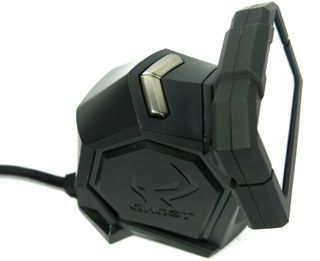
The display’s resolution is rather low, but it’s good enough for text. It'll keep you informed about the currently-active profile, the sensor's current resolution, the polling rate, and remaining charge in the batteries. You get a warning when the mouse needs to be recharged with a power plug symbol, as you can see in the image below.
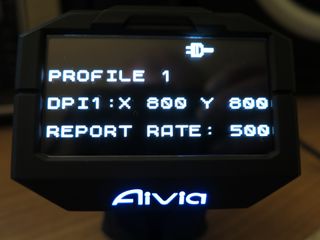
According to the label on the bottom of the charging station, power draw is 200 mA. That's a bit misleading though, since it only accounts for the display. Actually charging the mouse draws significantly more power, which is why it makes sense that the charging station’s cable features a Y-split to accommodate a second USB connector.
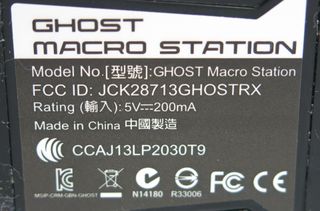
Rechargeable Batteries and Charging
The Aivia Uranium’s design has a big advantage in that any standard rechargeable battery can be used. Even normal (non-rechargeable) batteries work, even though you have to remember never to try charging them. The two included generic rechargeable batteries are decent, but they should be charged completely before using them with an external charger, not a rapid charger.
Running the rechargeable batteries all the way down on a regular basis should be avoided. You can discharge Gigabyte's bundled nickel–metal hydride batteries once a month to fight the memory effect. Another unique feature of this particular type of rechargeable battery is the optimization for a constant power supply over long periods of time. Unfortunately, they also lose a lot of their capacity after about 400 charge cycles, whereas lithium-ion rechargeable batteries last 20 to 30 percent longer.
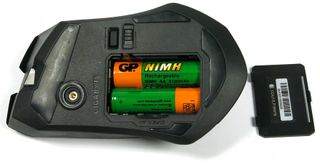
Connecting the mouse to its charging station is as easy as it gets, especially since the cable adjusts itself due to a spring-loaded mechanism in the station.
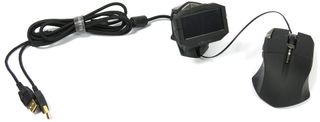
The charging cable is 50 cm-long, and very thin and flexible. In a pinch, you can use the Aivia Uranium hardwired. It's both well thought-out and practical. But bear in mind that the USB connection only charges the mouse; it isn't used for data transmission.
Stay On the Cutting Edge: Get the Tom's Hardware Newsletter
Get Tom's Hardware's best news and in-depth reviews, straight to your inbox.


The charging process is generally fast thanks to rapid charging technology, but it’s also very dependent on the rechargeable batteries you use. Gigabyte's Aivia Uranium doesn’t draw much power, which is to say that it runs more than a day on one charge without turning it off. This is a big advantage compared to most mice that use smaller proprietary batteries. If you want to make sure that the batteries don't run out of power, you can always buy your own higher-capacity lithium-ion rechargeable batteries, which also don’t need any maintenance.
-
jankeke Nice review !But on the 2nd page, 9th § you wrote :This is another place where Gigabyte's Aivia Uranium offers good economics.I guess it should say :This is another place where Gigabyte's Aivia Uranium offers good ergonomics.Reply -
kamhagh i would rather buy g602 (have it currently and love it) G600 or g700s! maybe g100 or g500s depends on need :)Reply -
Phillip Wager this just does not seem worth the high price. it just seems like too much of an office mouse than a gaming mouse honestly thats marketed for gamers.Reply -
atavax I don't understand why you think heavy is ok for low sensitivity and bad for high sensitivity. It is quite the opposite. Low sensitivity means you are moving your mouse way more and lifting your mouse way more, which means heft is a big problem. While many high sensitivity players move their mouse very little and many actually prefer heavy mice.Reply -
atavax Also many low sensitivity players use 400 or 450 dpi. the lowest native step being 800 is not good for low sensitivity players.5600 DPI is ridiculously high. Almost all professional shooter players use below 1000 dpi. The higher the max dpi, the more smoothing is needed to be built into the mouse to counter jitter, the laggier the mouse is. Any mouse above 3,000 dpi is not taking high level mouse performance seriously.Reply
Most Popular



